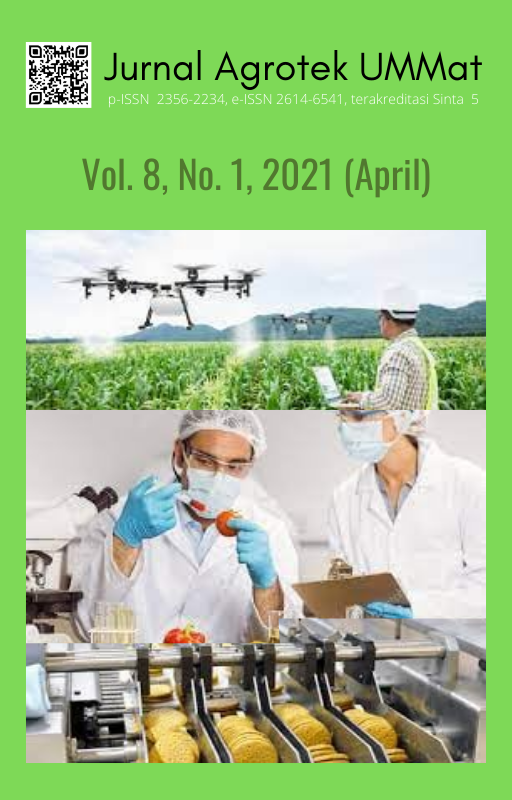MUTU ORGANOLEPTIK BROWNIES PANGGANG YANG TERBUAT DARI TEPUNG TERIGU, MOCAF DAN TEPUNG KELOR
DOI:
https://doi.org/10.31764/jau.v8i1.5973Keywords:
Brownies, Mocaf flour, Moringa flour, Wheat flourAbstract
Brownies are chocolate cakes that are very popular and liked by almost everyone. The main raw material of processing brownies is flour which until now is still imported. The addition of mocaf and moringa leaf flour can to reduce flour use and increase organoleptic of brownies. The aim of this study was to find out the effect of substitution of wheat flour, mocaf and moringa leaf flour on organoleptic brownies. The method that used in this experiment is a Complete Random Design (CRD) with one factor that was substitution of flour, mocaf and moringa leaf flour whose treatment is A0 (Flour 50% : Mocaf 50%: Moringa leave flour 0%/control), A1 (Flour 47,5% : Mocaf 47,5% : Moringa leave flour 5%), A2 (Flour 45% : Mocaf 45% : Moringa leave flour 10%), A3 (Flour 42,5% : Mocaf 42,5% : Moringa leave flour 15%), A4 (Flour 40% : Mocaf 40% : Moringa leave flour 20%), dan A5 (Flour 37,5% : Mocaf 37,5% : Moringa leave flour 25%). The data of the research were analyzed using Analysis of Varience at level 5% and tested continued using Tukey’s Honestly Significant Difference Test (Tukey’s HSD) at the same level if there was a real difference. The results showed that substitution of flour, mocaf and moringa leaf flour on brownies has a real effect on organoleptics in hedonic test on color, texture and taste as well as organoleptic scoring on color, aroma, texture and taste, but has no effect on hedonic test in aroma. For the quality of organoleptic brownies it is known that the best treatment on hedonic tests of texture and taste parameters produced by treatment A1 (Flour 47,5% : Mocaf 47,5% : Moringa leave flour 5%) with likes criteria and for scoring tests are produced by the same treatment on aroma, texture and taste parameters with their respective criteria that are typical brownies, moist and sweet taste. The best treatment on color scoring tests is produced by treatment A5 (Flour 37,5% : Mocaf 37,5% : Moringa leave flour 25%) whith criteria are brown.
References
Ansarullah (2019) “Pengaruh substitusi tepung daun kelor (Moringa oleifera) terhadap kualitas sensorik, kandungan zat besi (Fe) dan aktivitas antioksidan roti tawar,†Jurnal Sains dan Teknologi Pangan, 5(4), hal. 2993–3005.
Antara, N. dan Wartini, M. (2014) Aroma and flavor compounds. Denpasar.
Astutik, D. (2020) Penambahan serbuk daun kelor (Moringa Oleifera) terhadap sifat fisikokimia dan organoleptik mie kering mocaf. Universitas Semarang.
Atia, F., Nela, E. dan Nanda, T. (2019) “Sifat kimia dan sensori brownies berbahan baku tepung mocaf, jagung dan kedelai hitam,†Jurnal Teknologi Pangan, 2(2), hal. 24–34.
Barrett, D.M., Beaulieu, J.C. dan Shewfelt, R. (2010) “Color, flavor, texture, and nutritional quality of fresh-cut fruits and vegetables: desirable levels, instrumental and sensory measurement, and the effects of processing,†Critical Reviews in Food Science and Nutrition, 50, hal. 369–389. doi:10.1080/10408391003626322.
Dewi, D. (2018) “Substitusi tepung daun kelor (Moringa oleifera L.) pada cookies terhadap sifat fisik, sifat organoleptik, kadar proksimat, dan kadar Fe,†Ilmu Gizi Indonesia, 1(2), hal. 104–112.
Hardjanti, S. (2008) “Potensi daun katuk sebagai sumber zat pewarna alami dan stabilitasnya selama pengeringan bubuk dengan maltodekstrin,†Jurnal Penelitian Saintek, 13(1), hal. 1–18.
Ilona, A. dan Ismawati, R. (2015) “Pengaruh penambahan ekstrak daun kelor dan waktu inkubasi terhadap sifat organoleptik yoghurt,†Jurnal Tata Boga, 4(3), hal. 151–159.
Kemp, S., Hollywood, T. dan Hort, J. (2009) Sensory evaluation a practical handbook. United Kingdom: John Wiley & Sons.
Krisnadi, A.D. (2015) Kelor super nutrisi. Blora: Pusat Informasi dan Pengembangan Tanaman Kelor Indonesia. Tersedia pada: https://kelorina.com/ebook.pdf.
Lala, H., Susilo, B. dan Komar, N. (2013) “Uji karakteristik mie instan berbahan-baku tepung terigu dengan substitusi mocaf,†Jurnal Bioproses Komoditas Tropis, 1(2), hal. 11–20.
Mahmood, K.T., Tahira, M. dan Ikram, U.H. (2010) “Moringa oleifera: a natural gift-A review,†Journal of Pharmaceutical Sciences and Research, 2(11), hal. 775–781.
Nurhadi, B. dan Nurhasanah (2010) Sifat fisik bahan pangan. Bandung: Widya Padjadjaran.
Prakoso, P. (2013) Pastry & Bakery Brownies. Jakarta: Bukukita.com.
Rahayu, W.P. (1998) Penuntun praktikum organoleptik. Bogor: Fakultas Teknologi Pertanian Institut Pertanian Bogor.
Rauf, R. (2015) Kimia pangan. Yogyakarta: CV Andi Offset.
Reily, M. (2018) Kebutuhan meningkat, impor gandum diprediksi capai 11,8 juta ton. Tersedia pada: https://katadata.co.id/ekarina/berita/5e9a560373852/kebutuhan-meningkat-impor-gandum-diprediksi-capai-118-juta-ton.
Roihanah, M. (2014) “Pengaruh jumlah karagenan dan ekstrak daun pandan wangi (Pandanus Amaryllifolius) terhadap sifat organoleptik jelly drink daun kelor (Moringa Oleifera),†Jurnal Tata Boga, hal. 96–105. Tersedia pada: https://ejournal.unesa.ac.id/index.php/jurnal-tata boga/article/view/9038.
Siwianisti, P. (2013) Substitusi tepung biji nangka pada pembuatan kue bolu kukus ditinjau dari kadar kalsium, tingkat pengembangan dan daya terima. Universitas Muhammadiyah Surakarta.
Suryani, N.M. (2019) “Studi eksperimen tepung mocaf (Modified Cassava Flour) menjadi brownies kukus,†Jurnal Bosaparis: Pendidikan Kesejahteraan Keluarga, 10(1), hal. 11–22.
Vivian, V. dan Anastasya, M.. (2018) “Sifat organoleptik mi instan tepung ubi jalar putih penambahan tepung daun kelor,†Jurnal Teknologi Pangan, 1(1), hal. 1–13.
Winarno, F.G. (2004) Kimia pangan dan gizi. Jakarta: PT Gramedia Pustaka Utama.
Downloads
Published
Issue
Section
License
Authors who publish articles in Jurnal Agrotek Ummatagree to the following terms:- Authors retain copyright of the article and grant the journal right of first publication with the work simultaneously licensed under a CC-BY-SA or The Creative Commons Attribution–ShareAlike License.
- Authors are able to enter into separate, additional contractual arrangements for the non-exclusive distribution of the journal's published version of the work (e.g., post it to an institutional repository or publish it in a book), with an acknowledgment of its initial publication in this journal.
- Authors are permitted and encouraged to post their work online (e.g., in institutional repositories or on their website) prior to and during the submission process, as it can lead to productive exchanges, as well as earlier and greater citation of published work (See The Effect of Open Access).

